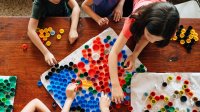11 Books to Encourage Creative Young Artists
These stories about artists and illustrators known for their inventive use of materials encourage creativity in young learners.
Your content has been saved!
Go to My Saved Content.On a road trip to Great Falls, Montana, I visited the Paris Gibson Square Museum of Art. In its permanent collection are Lee Steen’s “tree people”—one-of-a-kind figures created from Y-shaped branches and accessorized with paint and found objects. Each tree person is unique, and looking at them collectively it’s easy to appreciate the time, resources, and imagination that went into creating this motley crew.
After seeing that exhibit I was inspired; I wanted to make a tree person. My friend took me “shopping” in the woods for a perfect fallen Y- shaped branch. We found one and dragged the taller-than-me stick back to the workshop, where I used spray paint and supplementary objects to give my tree person personality. Many hours later, my tree cowboy was finished, complete with a mustache and little bandana.
If we want students to be creative thinkers, problem solvers, and innovators, it’s necessary for teachers to seek out opportunities that might foster inspiration. It’s also crucial for children to understand that the artistic road has been traveled many times before and that the journey toward inspiration can begin with identifying pathfinders. Reflecting on the works of resourceful artists, in particular, and learning about their creative journey encourages children to trust their own imagination and potential for ingenuity.
Children can begin their exploration of resourceful artists close to home in the familiar context of children’s books. Illustrators Aya Gordon Noy and Hanoch Piven integrate images of unconventional objects in unexpected and whimsical ways in their picture books. Artists like Noy and Piven can inspire children to apply a mixed-media approach to their own creations.
For a deeper dive into a resourcefully creative life, the 11 books that follow celebrate resourceful artists and their commitment to imaginative ingenuity. While some of these self-taught and professionally trained artists are from different eras, common to each artist’s work is the ability to engage audiences in marveling about both their artistic process and the results.
Many schools that embrace initiatives such as STEAM will find an invaluable resource in these artists and the picture books about them; the books as a collective can support multidiscipline discussions on topics such as engineering, geography, conservation and various art mediums. Reading one of these titles will be inspirational; reading all of the books sends a message to children that imagination and resourcefulness has meaning and value in the classroom as well as the world.
Books to Inspire Budding Artists
The Wonderful Towers of Watts, by Patricia Zelver, illustrated by Frane Lessac. Simon (Sam) Rodia (1879–1965) creatively utilized discarded materials to construct the Watts Towers in Los Angeles. (Preschool–K)
In Mary’s Garden, by Tina and Carson Kügler. Mary Nohl (1914–2001) lived in Fox Point, Wisconsin, where she enhanced her home by creating sculptures made from found objects. (Preschool–grade 2)
Birds of a Feather: Bowerbirds and Me, by Susan L. Roth. Author-illustrator Roth compares her artwork and creative process to that of Australian bowerbirds, renowned for their nests made from found objects. (Grades K–3)
Sandy’s Circus: A Story About Alexander Calder, by Tanya Lee Stone, illustrated by Boris Kulikov. Calder (1898–1976) created sculptures when he was a child and later in life created a portable circus made from wire and found objects. (Grades 1–3)
The Scraps Book: Notes From a Colorful Life, by Lois Ehlert. Ehlert (1934–2021) was a children’s author and illustrator. In her autobiographical picture book, she shares her inspirations for her books and provides examples of resourcing materials for her collages. (Grades K–5)
A Life Made by Hand: The Story of Ruth Asawa, by Andrea D’Aquino. When Ruth Asawa (1926–2013) was a child, she made things from found objects, which was foundational to her later work as a professional artist creating intricate wire sculptures. (Grades 1–3)
Magic Trash: A Story of Tyree Guyton and His Art, by J.H. Shapiro, illustrated by Vanessa Brantley-Newton. Tyree Guyton (b. 1955) transformed his childhood neighborhood in Detroit by using paint and creating found-object sculptures. (Grades 1–3)
Mr. Cornell’s Dream Boxes, by Jeanette Winter. Joseph Cornell (1903–72) created intricately designed shadow boxes using found objects. (Grades 1–3)
Rock by Rock: The Fantastical Garden of Nek Chand, by Jennifer Bradbury, illustrated by Sam Boughton; and The Secret Kingdom: Nek Chand, a Changing India, and a Hidden World of Art, by Barb Rosenstock, illustrated by Claire A. Nivola. These two stories about Indian artist Chand (1924–2015) tell of his journey to create the sculpture garden called the Rock Garden of Chandigarh. (Grades 2–5)
Bottle Tops: The Art of El Anatsui, by Alison Goldberg, illustrated by Elizabeth Zunon. Anatsui is a Ghanaian artist living in Nigeria. He looks for opportunities to use traditional art techniques to transform old and used objects, like bottle caps, into awe-inspiring works of art. (Grades 2–7)
